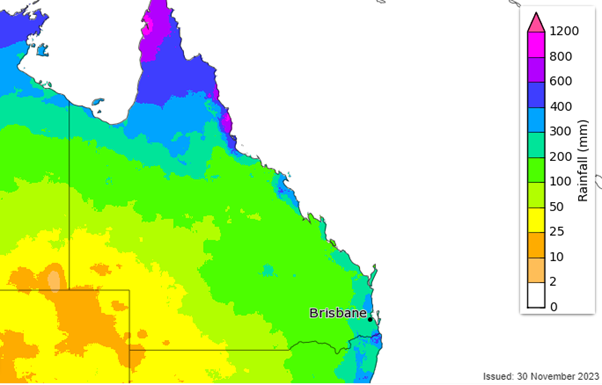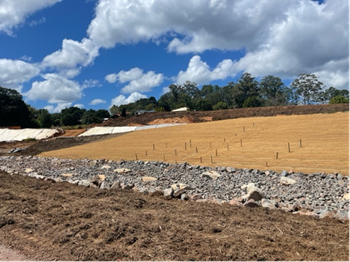
|
Newsletter #6 December 2023
|
|
Wet Season outlook
|
The Bureau of Meteorology (BOM) have predicted only slightly below median rainfall for the Southeast Queensland region over the next few months (December – February), with 50 - 75% chance of totals exceeding 400 mm for the three-month period. Over the summer months, high intensity rainfall events and storms are more likely. Due to this, it is imperative that your site is prepared for storms and predicted rainfall. This includes ensuring your site is suitably stabilised during Christmas shutdowns.
|

|
Source: Bureau of Meteorology (BOM), 2023
|
|
Preparing your site for Christmas shut down
|
Coming into the holiday season, it is likely that you will demobilise your site for an extended period to enjoy Christmas and New Years. Unfinished earthworks and disturbed areas present a risk of erosion and impact to the surrounding environment. It is important to suitably stabilise and prepare your site. This can be achieved a combination of ways dependent on your site and stage of works, for example by:
- Engage your consultant: Contact a suitable erosion and sediment control (ESC) consultant, to conduct a site inspection and advise of appropriate corrective actions to be taken to ensure the site will be suitable for a shut down.
- Stabilise disturbed areas: Ensure unfinished earthworks and exposed soils are suitably stabilised and protected to prevent erosion, including stockpiles.
- Maintain controls and suitable access to controls: Monitor erosion and sediment controls and maintain controls in a condition representative of current best practice. For example, ensuring ESC devices are free from silt and material to increase capacity.
- Assess drainage measures: The proper management of water flow through and around site is essential in surface water management during construction and bulk earthworks. Assessing diversion drains and drainage control measures will aid sediment retention on site, the effective treatment of site runoff, decrease flow velocity, minimise risk of rill and gully erosion, and decrease the volume of water to be managed through clean water diversions. For example, ensure all dirty water diversions are directed to a suitable control, and all clean water diversions are lined and stabilised.
- Ensure appropriate materials on site: Making sure there are appropriate controls and materials on site which can be employed prior to rainfall or as contingency is important to enable the effective operation of control measures. For example, having enough flocculant on site to treat site runoff to basin, or extra ESC materials which can be used where maintenance is required.
- Inspection and monitoring regime: It is good practice to assess the effectiveness of controls through regular site inspections and water quality monitoring, particularly pre and post rainfall. This should include conducting thorough pre-shutdown inspections to inform appropriate amendments to the site. This will promote effective maintenance and action to be taken if failures of controls are observed.
- Housekeeping: Maintain a tidy site and remove/contain any construction waste to prevent dispersal.
|
|
Minimising Soil disturbance
|
Where practical, it is more effective to prioritise preventing or minimising erosion oppose to allowing erosive processes and trapping runoff and sediment. This is commonly achieved through drainage control measures and erosion control measures:
- Minimising disturbance: This is the most effective erosion control measure. The less area left exposed; the less erosion will occur.
- Groundcover: Groundcover can be achieved multiple ways including through temporary measures such as geofabric, or permanent erosion control such as turfing and revegetation.
- Progressive stabilisation: Stabilising disturbed/exposed areas as soon as reasonably practical or if the area will not be worked for an extended amount of time.
- Drainage management: Divert clean water around site where practical, direct dirty water to sediment controls, maintain effective slope length, and control water on your site and leaving your site appropriately (for example, velocity controls such as check dams).
- Timing and staging earthworks: Timing bulk earthworks to occur in low rainfall months, and staging works to minimise area exposed to erosion at one time.
|

|
Various forms of stabilisation demonstrated at a Hall Contracting site in Palmwoods, including mulch, jute mesh, rock, and geofabric. Site project manager Jai Smith states, ‘we have prioritised the need for stabilising our site progressively to prevent erosion, resulting in easier site management particularly during rainfall.’
|
Merry Christmas
Thank you to everyone who has joined us this past year on our journey in promoting the health of our waterways and coast by reducing impacts from construction and development. From the team at Sunshine Coast Council, we wish you and your loved ones a Merry Christmas and Happy New Year.
|
Please assist Council in keeping our local waterways, beaches and environment healthy
and sustainable for all to enjoy.
|
|
|
|
|

|
|
|
|
|